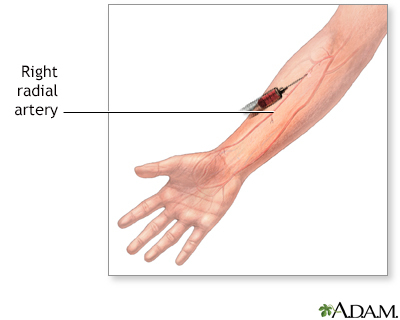Blood gases
Definition
Blood gases are a measurement of how much oxygen and carbon dioxide are in your blood. They also determine the acidity (pH) of your blood.
Alternative Names
Arterial blood gas analysis; ABG; Hypoxia - ABG; Respiratory failure - ABG
How the Test is Performed
Usually, blood is taken from an artery. In some cases, blood from a vein may be used (venous blood gas).
Most commonly, blood may be collected from one of the following arteries:
- Radial artery in the wrist
- Femoral artery in the groin
- Brachial artery in the arm
The health care provider may test circulation to the hand before taking a sample of blood from the wrist area.
The provider inserts a small needle through the skin into the artery. The sample is quickly sent to a laboratory for analysis.
How to Prepare for the Test
There is no special preparation. If you are on oxygen therapy, the oxygen concentration must remain constant for 20 minutes before the test.
Tell your provider if you are taking any blood-thinning medicines (anticoagulants), including aspirin.
How the Test will Feel
When the needle is inserted to draw blood, some people feel moderate pain. Others feel only a prick or stinging. Afterward, there may be some throbbing or slight bruising. This soon goes away. Pain and discomfort tend to be worse than drawing blood from a vein.
Why the Test is Performed
The test is used to evaluate respiratory diseases and conditions that affect the lungs. It helps determine the effectiveness of oxygen therapy or non-invasive ventilation (BiPAP). The test also provides information about the body's acid/base balance, which can reveal important clues about lung and kidney function and the body's general metabolic state.
Normal Results
Values at sea level:
- Partial pressure of oxygen (PaO2): 75 to 100 millimeters of mercury (mm Hg), or 10.5 to 13.5 kilopascal (kPa)
- Partial pressure of carbon dioxide (PaCO2): 38 to 42 mm Hg (5.1 to 5.6 kPa)
- Arterial blood pH: 7.38 to 7.42
- Oxygen saturation (SaO2): 94% to 100%
- Bicarbonate (HCO3): 22 to 28 milliequivalents per liter (mEq/L)
At altitudes of 3,000 feet (900 meters) and higher, the oxygen value is lower.
Normal value ranges may vary slightly among different laboratories. Some laboratories include different measurements. Talk to your doctor about the meaning of your specific test results.
What Abnormal Results Mean
Abnormal results may be due to lung, kidney, metabolic diseases, or medicines. Head or neck injuries or other injuries that affect breathing can also lead to abnormal results.
Risks
There is little risk when the procedure is done correctly. Veins and arteries vary in size from one person to another and from one side of the body to the other. Taking blood from some people may be more difficult than from others.
Other risks associated with having blood drawn are slight, but may include:
- Fainting or feeling lightheaded
- Multiple punctures to locate blood vessels
- Hematoma (blood buildup under the skin)
- Excessive bleeding
- Infection (a slight risk any time the skin is broken)
Gallery

References
Chernecky CC, Berger BJ. Blood gases, arterial (ABG) - blood. In: Chernecky CC, Berger BJ, eds. Laboratory Tests and Diagnostic Procedures. 6th ed. St Louis, MO: Elsevier Saunders; 2013:208-213.
Weinberger SE, Cockrill BA, Mandel J. Evaluation of the patient with pulmonary disease. In: Weinberger SE, Cockrill BA, Mandel J, eds. Principles of Pulmonary Medicine. 6th ed. Philadelphia, PA: Elsevier; 2019:chap 3.